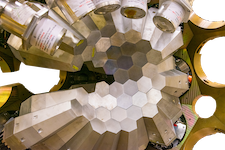Speaker
Description
Abstract: We propose to measure lifetimes of excited states in A~90 nuclei between N=Z and the closed neutron shell at N=50 using the Recoil Distance Doppler Shift (RDDS) technique. Level lifetimes of low-lying yrast states in this region of the nuclear chart are sensitive to the competition between isovector pairing forces resulting in seniority symmetry, isoscalar correlations, and the emergence of collective strength. Furthermore, electromagnetic transition strengths are often more sensitive than level energies to small components of the nuclear wave function and may therefore provide critical tests of nuclear models.
The lifetimes of states below the seniority isomers are difficult to access due to delayed feeding from the seniority isomers themselves when investigated in-beam in standard fusion-evaporation reactions and therefore poorly known. This warrants alternative approaches, such as fast-timing measurements following isomer decays or via controlled state feeding as addressed in the present proposal.
Recently, new and partly conflicting results on seniority symmetry in 94Ru, near the proton g9/2 mid-shell have been reported and received widespread attention due to the implications for state-of-the art theory. This proposal addresses this issue with a high-precision measurement using AGATA in conjunction with the PRISMA spectrometer. The experiment will focus primarily on remeasuring the lifetimes of the first excited 4+ and 2+ states in the semimagic nucleus 94Ru and measuring lifetimes of low-lying excited states in several neighboring N=48-50 isotones with high precision. In the N=48 isotones, experimental information on the excited-level lifetimes for several nuclides is crucially missing or lacks sufficient precision below the 8+ seniority isomers. The experiment also aims to investigate previously obtained evidence for octupole collectivity in this region of the nuclear chart.
The experiment will combine the use of a multi-nucleon transfer reaction mechanism that produces significant direct feeding of the states of interest with a detection system, AGATA+PRISMA+Differential plunger, that has optimal performance for RDDS measurements. The experiment will focus primarily on remeasuring the lifetimes of the 4+ and 2+ states in 94Ru and measuring lifetimes of low-lying excited states in the N=48 nuclides 92Ru and 90Mo and intermediate-spin states in the N=49 nucleus 92Tc nucleus with high precision. In the N=48 isotones, experimental information on the excited-level lifetimes for several nuclides are crucially missing below the 8+ seniority isomers. In the 92Tc nucleus lifetime measurements of intermediate-spin states will enable us to fine tune the neutron-proton interaction in large-scale shell model calculations by comparing measured and calculated M1 and E2 transition strengths. The experiment also aims to investigate previously obtained evidence for octupole collectivity in this region of the nuclear chart. The neutron deficient A~90 nuclei will be produced by multi-nucleon transfer reactions induced by a 410 MeV 92Mo beam (3 pnA intensity) impinging on a ~2 mg/cm2 thick 58Ni target. Eight days of beam time are requested including one day for tuning the detectors.

